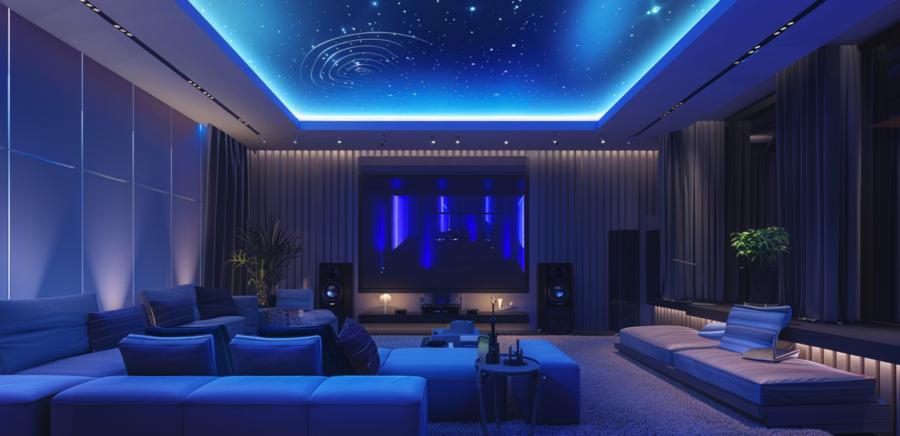Why the Ceiling Matters
Sound doesn’t politely stop when it hits the floor. It ricochets, bounces, and swirls, often creating that dreaded effect where dialogue sounds like it’s coming from a bathroom down the hall. Treating the walls might seem like the obvious move, but the ceiling is a major reflector of sound waves, especially in media rooms where speakers are blasting both horizontally and vertically. By taming the ceiling, you can sharpen dialogue intelligibility, reduce flutter echoes, and give the entire soundscape a sense of clarity. Think less “tin can telephone” and more “velvet articulation.”Floating Cloud Panels
Imagine a cluster of panels gently hovering above your seating area, like a minimalist spaceship squadron parked for movie night. Floating cloud panels are among the most effective ways to rein in unruly sound. Suspended a few inches below the ceiling, these absorptive panels intercept reflections before they can muddle dialogue or fatigue your ears.They can be made from materials such as acoustic foam, fiberglass, or eco-friendly recycled fiber. For those who blanch at the thought of office-style ceiling tiles, worry not—modern cloud panels come wrapped in fabrics that range from sober charcoal to audacious crimson. A row of them can even double as a design statement: functional sculpture with an acoustic bonus.
Star Ceilings and Atmosphere
Now, if you’re willing to embrace a little theatricality, star ceilings are a marriage of ambience and acoustics. These are panels with embedded fiber-optic lights that create the illusion of a night sky. Not only do they make a room feel more cinematic, but when constructed with absorptive backings, they soften echoes at the same time.Is it indulgent? Yes. Does it make your guests gasp, then immediately ask how much you spent? Also yes. But compared to endless throw pillows or a second subwoofer, the cost can be justified by the double payoff: the immersive atmosphere and the improved sound. There’s also something undeniably soothing about watching a movie under a sky that twinkles on command—without worrying about rain or the neighbor’s security floodlight.
Dropped Clouds and Design Integration
Dropped clouds, unlike their floating cousins, are typically larger continuous structures. They can be shaped into rectangles, ovals, or even asymmetrical patterns that look like they belong in a boutique hotel lobby. The beauty here is integration: you can tuck in LED strips for indirect lighting, hide cabling for ceiling speakers, or even create zones that subtly guide how people use the room.When well-designed, dropped clouds allow a room to straddle that tricky line between functional media space and stylish lounge. The trick is balance. Go too big, and your ceiling feels like it’s descending with all the menace of a sci-fi mothership. Keep the scale proportionate to your space, and the effect is sleek, almost architectural.
Material Choices and Cost
Acoustic treatments don’t all arrive wrapped in luxury price tags. At one end, you’ve got professional-grade panels clad in designer fabrics, promising both performance and aesthetics. At the other, you’ve got DIY builds involving timber frames, mineral wool, and a staple gun that may or may not misfire at the wrong moment.Cost often scales with two factors: finish quality and ease of installation. If you want panels that look like art pieces, expect to pay for the privilege. If you’re comfortable wrestling with insulation batts and a staple gun on a Saturday afternoon, the savings can be substantial. Either way, it’s worth remembering that spending thousands on electronics only to let sound waves ricochet freely overhead is like buying a Ferrari and then driving it exclusively in second gear.
Balancing Acoustics and Aesthetics
Of course, not every household welcomes the idea of giant grey slabs looming overhead. A good solution marries acoustic performance with visual subtlety. Panels can be wrapped in custom fabrics to blend with décor, painted in muted tones, or even disguised as art. Some designers create geometric clusters that look like installations rather than acoustic gear.The point is: overhead treatments don’t have to scream “recording studio.” They can be as invisible or as bold as you want. Just ensure they’re positioned where they’ll actually intercept reflections—style doesn’t excuse poor placement. And resist the temptation to overdo it; a room can start to feel like a padded cell surprisingly quickly.
Other Ceiling Tricks Worth Considering
Beyond panels and clouds, ceilings can do more for ambience:- Indirect cove lighting that washes walls without bleaching the screen image
- Acoustic diffusers disguised as sculptural elements to scatter sound evenly
- Perforated wooden panels that tame echoes while lending warmth to the look
- Retractable ceiling sections that hide projectors or speakers when not in use
Raising the Roof, Sensibly
A good ceiling treatment is not about extravagance. It’s about controlling reflections and setting a mood that makes a room comfortable, intelligible, and genuinely enjoyable. If done properly, overhead treatment can make dialogue crisp without having to ride the volume button like an Olympic sport, and it can transform a plain room into a place that feels considered, not cobbled together.It may not be the part of your home you most often look at, but when treated with care, the ceiling will quietly (and sometimes dazzlingly) prove that it was always the most underestimated surface in the room. Instead of being just the thing you occasionally repaint or curse for dripping condensation, it becomes a silent ally in the quest for sonic and visual pleasure.
Article kindly provided by cinema-at-home.co.uk


